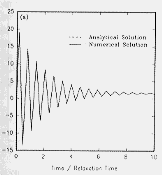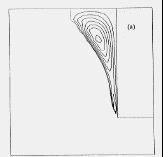EXPLICIT NUMERICAL
SIMULATION OF TIME-DEPENDENT VISCOELASTIC FLOW PROBLEMS BY A FINITE ELEMENT /
FINITE VOLUME METHOD
Toru Sato* and Stephen M. Richardson
Department of
Chemical Engineering and Chemical Technology,
Imperial College, London SW7 2BY (U.K.)
Abstract
A combination of the finite element method and the finite
volume method has been developed for time-dependent viscoelastic flow problems.
The governing system of equations is decoupled provided that a reasonably small
time-increment is used, which is obtained from a CFL condition taking into
account a local vorticity wave speed. The momentum equation is solved
explicitly with respect to time by a finite element method. The constitutive
equation for an upper-convected Maxwell model is solved implicitly by finite
volume methods. Case studies have been conducted for start-up of planar
Poiseuille flow and planar four-to-one contraction flow for upper-convected
Maxwell and Oldroyd-B fluids. Numerical results agree with analytical solutions
for shock propagation in start-up of Poiseuille flow with no upper limit on the
Weissenberg number We. In planar 4:1 contraction flow, the size of the
corner vortex compares well with experimental measurements and other numerical
predictions. An attempt to seek a critical value of We was stopped at We=2
because of transient behaviour of the viscoelastic flow. There are new
findings: vorticity separation from a re-entrant corner and a temporary lip
vortex in transient flow induced by an instantaneous increase of We.


